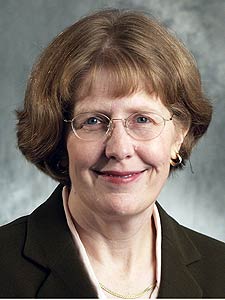|
Audio
Photos
More from MPR
|
 |
| Rep. Tina Liebling, a DFLer, represents Rochester. She's in favor of a four-year university in Rochester. (Photo courtesy of Minnesota House of Representatives) |
Rochester, Minn. — If you read the minutes of the Rochester Higher Education Development Committee meetings you'd suspect the proposed four-year entity already has an mascot. Imagine a guy in a lab coat with an electric guitar and spiky hair: He's the rock star researcher that will drive higher ed in Rochester.
The general idea is a highly specialized series of bioscience and engineering research programs, in a four-year plus graduate-level institution. Students would work closely with Mayo Clinic and IBM. The committee hopes they would then launch startup companies in Rochester. The dream is to make Minnesota into a bioscience hub. An economic impact study commissioned by the group isn't due out until April.
Government officials like Rochester DFLer Tina Liebling regularly attended the committee meetings over the last year.
"There's a tremendous synergy here," Liebling says. "And having the university participate more fully in that is the general idea. Now, how we're going to get that -- I think it's going to come a little bit in pieces."
The early projected price tag is $15 million in the next three years, then an additional $156 million over the next decade to get the campus operational.
Those figures are scandalous to some. Tuition at both MnSCU colleges and the U of M have seen double digit hikes over the past three years, and the Pawlenty administration has significantly cut both systems' budgets.
State Rep. Gene Pelowski, DFL-Winona, teaches at the local high school and sits on the Higher Education Finance Committee and the Education Policy and Reform Committee. He says he would support a higher education institution in Rochester if he saw a need. But he doesn't see a need, he sees a want.
"All of this is a very glitzy sort of foo-foo dust approach to higher education," Pelowski says. "If we do this, somehow something will happen. Well, I'm sorry, right now if we do this it's going to take resources. From where?"
Neither the U of M nor MnSCU say they have money in their budgets for this project. In fact, the U of M would need entirely new money to create this campus.
Liebling and Sen. Sheila Kiscaden, DFL-Rochester, both say IBM and Mayo Clinic indicate they'll contribute dollars. But Pelowski wants to know how much. And he says this is a ploy by the governor to gain votes.
"This is purely political. "This is going to Rochester and saying, 'You're the third most populous area of the state. I recognize that. I'm going to have my state-of-the-state there and I'm going to throw a four-year college at you,'" Pelowski said, referring to Gov. Pawlenty's focus on Rochester a year ago, when he announced his intention to pursue a university campus for the city.
Liebling says the election of a few Democrats from Rochester did play a role. But that doesn't mean the institution isn't necessary.
"You hate to think that it depends on these kinds of things, but the reality is the rest of the state didn't pay much attention to Rochester until it became a politically contested area," Liebling says.
Sen. Kiscaden agrees that politics helped this project move forward. But she adds that higher ed in Rochester has incrementally built programs, including the Mayo/U of M genomics partnership. And Rochester Area Technical College now has more than 6,000 students.
RCTC Faculty President Gregory Wright says the college is glad to see more higher ed in Rochester. But the staff don't like the suggestion that their freshman and sophomore course work isn't good enough for this proposed institution.
"If I understand their motivation, they believe they have to have freshman and sophomore classes to help pay for the junior and senior programs," Wright says. "But when you look at the cost of the programs that they're actually getting, a few freshmen and sophomores aren't going to pay for that."
Wright says he hasn't seen the proposal. But he says he hopes the desire for prestige isn't the deciding factor in the education budget next year.
The report from the Rochester Higher Education Development Committee is due out Wednesday morning.






